Let’s dive into the fascinating anatomy of an electric guitar, an instrument that has revolutionized music and captured hearts across generations. This iconic instrument, with its ability to produce electrifying sounds and transcend musical genres, is a marvel of design and engineering. Understanding the anatomy of an electric guitar is key to appreciating its versatility and the intricate interplay of its components.
From its sleek body to its vibrant strings, each part of the electric guitar plays a crucial role in creating its distinctive sound. Whether you’re a budding musician, a curious enthusiast, or a seasoned player, exploring the guitar’s anatomy will deepen your appreciation for this remarkable instrument.
Key Takeaways:
- The electric guitar’s core components are the body, neck, and pickups, which convert string vibrations to electrical signals.
- Different guitar types (solid, hollow, semi-hollow) influence tone and playability, suiting various genres and styles.
- Electronics (pickups, controls, selector switch) shape the instrument’s sound, offering diverse tonal options.
- The bridge and nut hold the strings from end to end, affecting tension, intonation, and playability.
- Components like the truss rod, frets, and tuning pegs maintain alignment, pitch accuracy, and tuning stability.
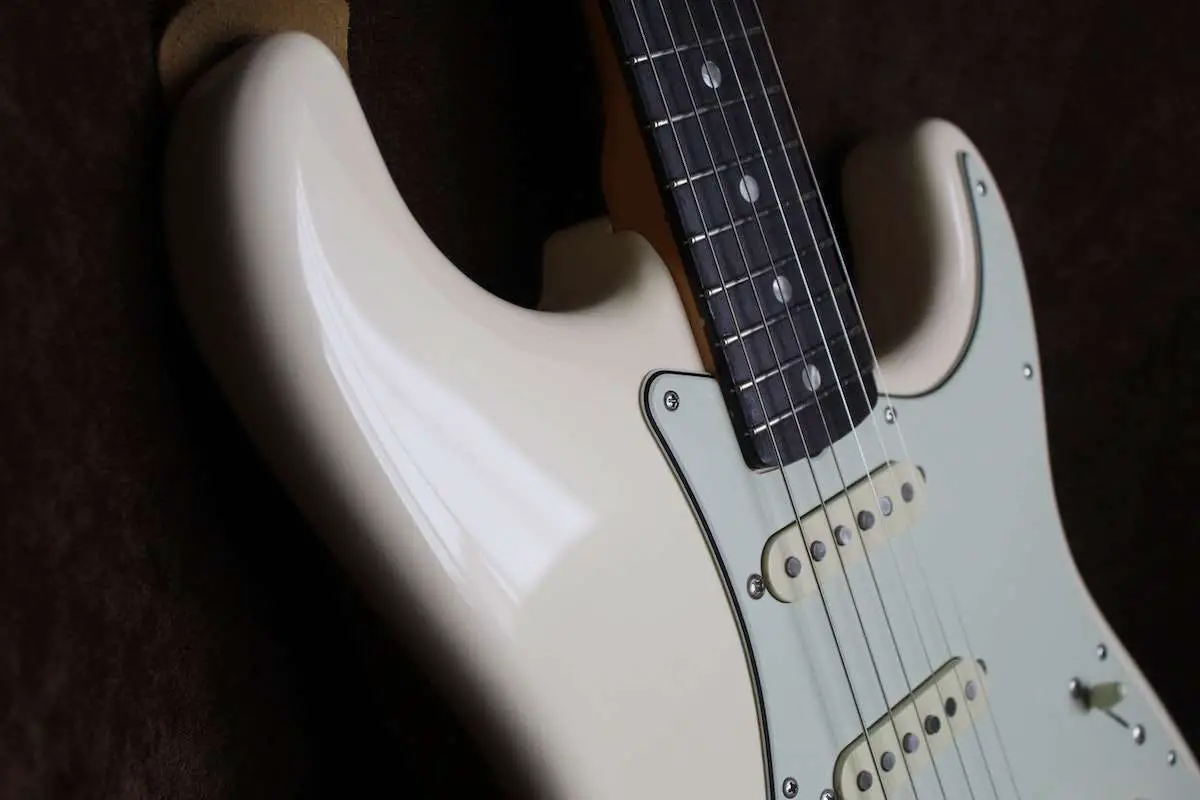
What Is An Electric Guitar?
An electric guitar is a musical instrument that, unlike acoustic guitars, relies on electronics to produce sound. While both guitars have a similar basic structure, most electric guitar have a solid body, often made of wood, whereas an acoustic guitar has a hollow body. The electric guitar uses pickups to capture the vibrations of the strings and convert them into electrical signals, which are then amplified to produce sound. This allows for greater control over the volume and tone of the instrument.
Additionally, the electric guitar typically has thinner strings and a narrower neck, making it easier to play certain techniques, such as bending notes or performing fast solos.
With its ability to produce a wide range of tones and be shaped by various effects pedals, the electric guitar has become synonymous with genres like rock, blues, and jazz, while the acoustic guitar is favored for folk, country, and more intimate acoustic performances.
Related: The History Of The Electric Guitar
Different Types Of Electric Guitars
When it comes to electric guitars, there are different types and models to explore that can cater to your musical tastes and playing preferences. Let’s take a closer look at the most common electric guitar construction types and popular guitar models you may encounter.
Construction Types:
Solid Body Electric Guitars :
Solid body electric guitars feature a solid, non-hollow body construction. They are versatile and popular across various genres, offering a focused and direct sound. With their ability to handle high-gain tones, solid body electric guitars are often associated with rock, pop, and metal music. They provide excellent sustain and are built to withstand the demands of amplified playing.
Hollow Body Electric Guitars:
Hollow body guitars have a hollow chamber in the body, which creates a more resonant and acoustic-like tone. They are favored in jazz, blues, and rockabilly genres, delivering a warm and rich sound. Hollow body guitars have a distinctive appearance and offer a greater emphasis on organic and natural tones.
5 Common Guitar Models
These guitar models represent a diverse range of styles and have been widely embraced by guitarists across different genres and skill levels. Whether you prefer the versatility of a Stratocaster, the power of a Les Paul, these models have left an indelible mark on the world of music.
Fender Guitars Stratocaster:
The Stratocaster is an iconic electric guitar model known for having its guitar’s body contoured, having versatile tone, and being comfortable to play. It features three single coil pickups, a tremolo bridge, and has been a favorite among guitarists in various genres for decades.
Fender Guitars Telecaster:
The Telecaster is a classic electric guitar model known for its simplicity, durability, and distinctive twangy sound. It features two single-coil pickups and a versatile tonal range, making it a preferred choice for country, rock, and alternative music.
Gibson Les Paul:
The Gibson Les Pauls are a legendary solid body electric guitar known for its thick and powerful tone. With its dual humbucker pickups and solid construction, it delivers warm, sustain-filled tones that are perfect for rock, blues, and heavier genres.
The SG is a double-cutaway electric guitar model that offers a lightweight design and a wide range of tones. It is favored by rock and blues guitarists for its aggressive sound, excellent playability, and striking appearance.
Gibson ES-335:
The ES-335 is a semi-hollow body electric guitar that combines the warmth and resonance of a hollow body with the feedback resistance of a solid body. It offers a versatile tone, making it suitable for jazz, blues, and rock genres.
The Parts Of An Electric Guitar
An electric guitar is a complex instrument that consists of several interconnected components, each playing a crucial role in producing its unique sound and facilitating the playing experience. We’ll be covering 19 different guitar parts, how each one works, and its location within the body:
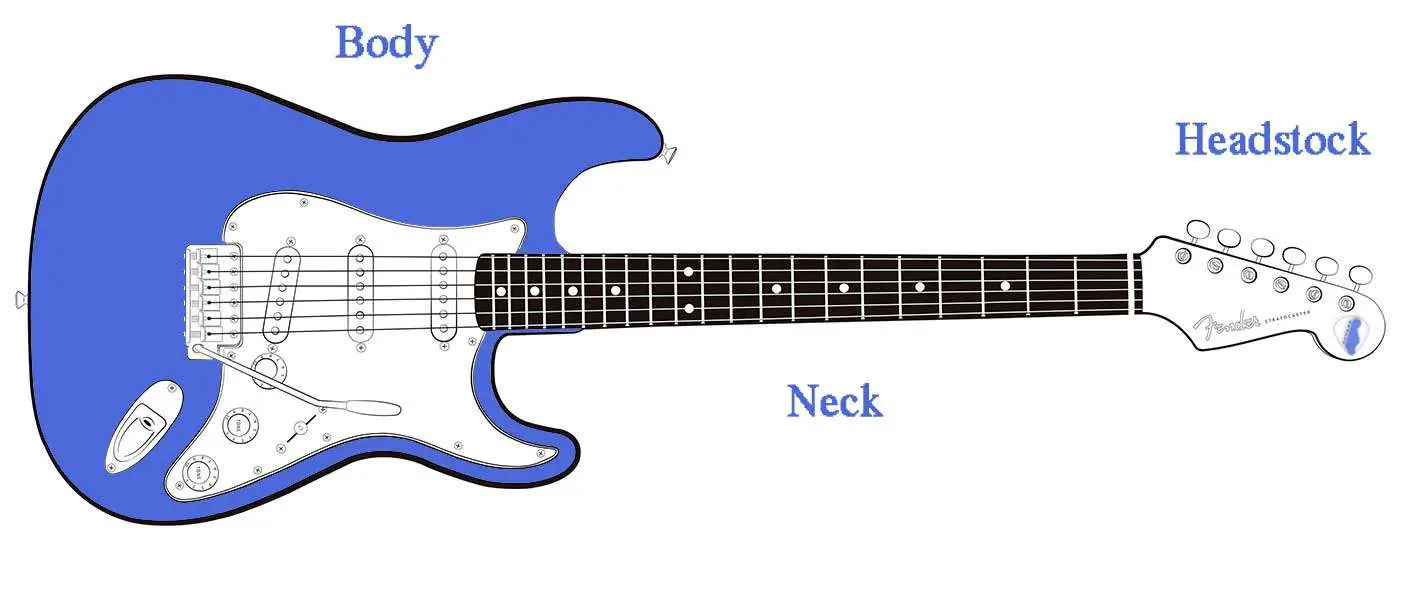
Guitar Body
The guitar body provides structural support and stability for the various components of the instrument, such as the pickups, bridge, controls, and output jack. These components need a solid foundation to ensure proper functioning and longevity.
Secondly, the body of the guitar plays a crucial role in ergonomics, providing a comfortable and balanced platform for the player. The contours and curves of the body are designed to fit against the player’s body, allowing for ease of playing and reduced fatigue during long sessions.
Additionally, the body contributes to the overall aesthetic appeal of the guitar, with its shape, design, and finishing playing a significant role in its visual appeal and individuality. The choice of materials for the body construction, such as woods or composite materials, can also impact the overall tone and sustain of the instrument.
In summary, the guitar body provides structural support, ergonomic comfort, and aesthetic appeal, all of which contribute to the overall performance and enjoyment of playing an electric guitar.
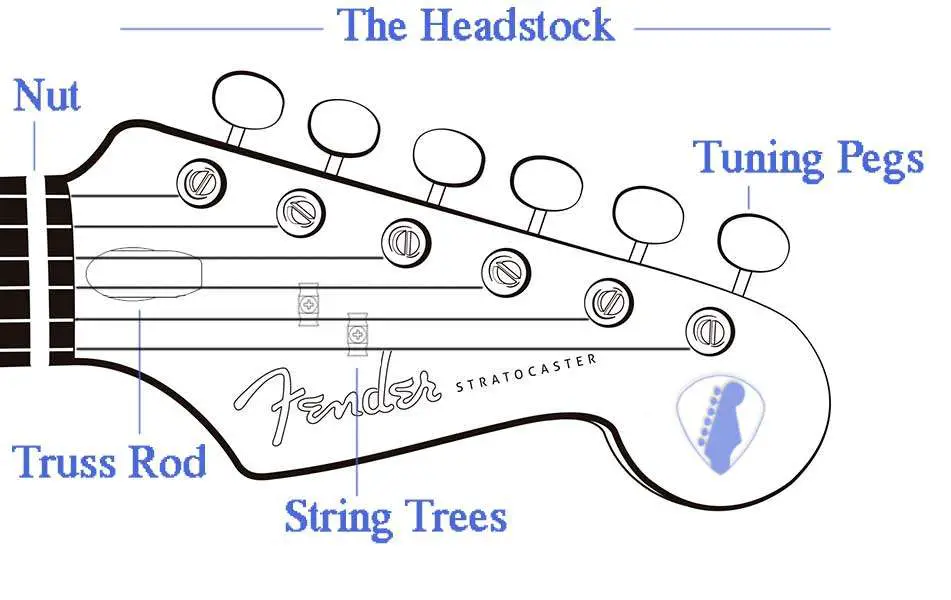
Headstock
The headstock on an electric guitar is the component located at the end of the neck that holds and anchors the guitar strings.
Its primary function is to provide a platform for the tuning machines (aka tuning pegs), which allow for the adjustment of string tension and pitch. By turning the tuners, players can tighten or loosen the strings to achieve the desired notes and ensure accurate tuning.
In addition to its functional role, the headstock contributes to the overall aesthetics and brand identity of the guitar, often featuring distinctive designs, logos, or markings. It is an essential element in the electric guitar anatomy, providing the means for tuning and adding to the instrument’s visual appeal.
Finally, it’s important to note that not all guitar’s have a headstock, particularly more modern guitars that are designed as “headless” instruments.
Tuning Pegs
Guitar tuning pegs, also known as machine heads or tuners, are essential components located on the headstock of a guitar. Their primary purpose is to adjust the tension and pitch of the strings. By turning the tuning pegs, players can tighten or loosen the strings to achieve the desired notes, ensuring accurate tuning.
The tuning pegs consist of gears that engage with the strings, allowing for precise and gradual adjustments to maintain proper pitch. They play a crucial role in the overall functionality of the guitar by providing the means for accurate tuning & intonation.
Locking tuners are also available for those who are seeking to maximize their tuning stability.
Related: How many guitar tunings are there?
String Retainers (String Tree)
A string tree, also referred to as a string retainer, is a small metal component found on the headstock of a guitar. Their function is to guide and maintain proper string tension and alignment, especially for most electric guitars with angled headstocks or certain string configurations.
String trees are typically positioned on the headstock, just above the guitar nut, and press down on the strings to prevent excessive buzzing or slipping. They help ensure consistent string pressure, enhance tuning stability, and improve overall playability, particularly for strings with a shallow break angle over the nut.
Truss Rod
The truss rod is an adjustable metal rod that runs through a compartment within the neck of a guitar. Its purpose is to provide structural support and control the curvature or “bow” of the neck.
The truss rod compartment, usually accessed through a small cover or opening on the headstock, allows for adjustments to be made using an appropriate tool.
By tightening or loosening the truss rod, players can counteract string tension and environmental factors to maintain the desired amount of neck relief, ensuring optimal playability and preventing issues such as fret buzz or high action.
Related: How to adjust guitar action height on an electric guitar
Guitar Nut
The guitar nut is a small, usually rectangular-shaped component located at the end of the guitar’s neck, near the headstock. It is typically made of bone, synthetic materials, or metal.
The primary function of the nut is to guide and support the strings as they transition from the headstock to the fretboard. It helps establish the proper string height and spacing, ensuring clear and accurate notes while preventing unwanted buzzing or rattling.
Additionally, the nut plays a role in determining the guitar’s intonation and contributes to the overall tone and sustain of the instrument.
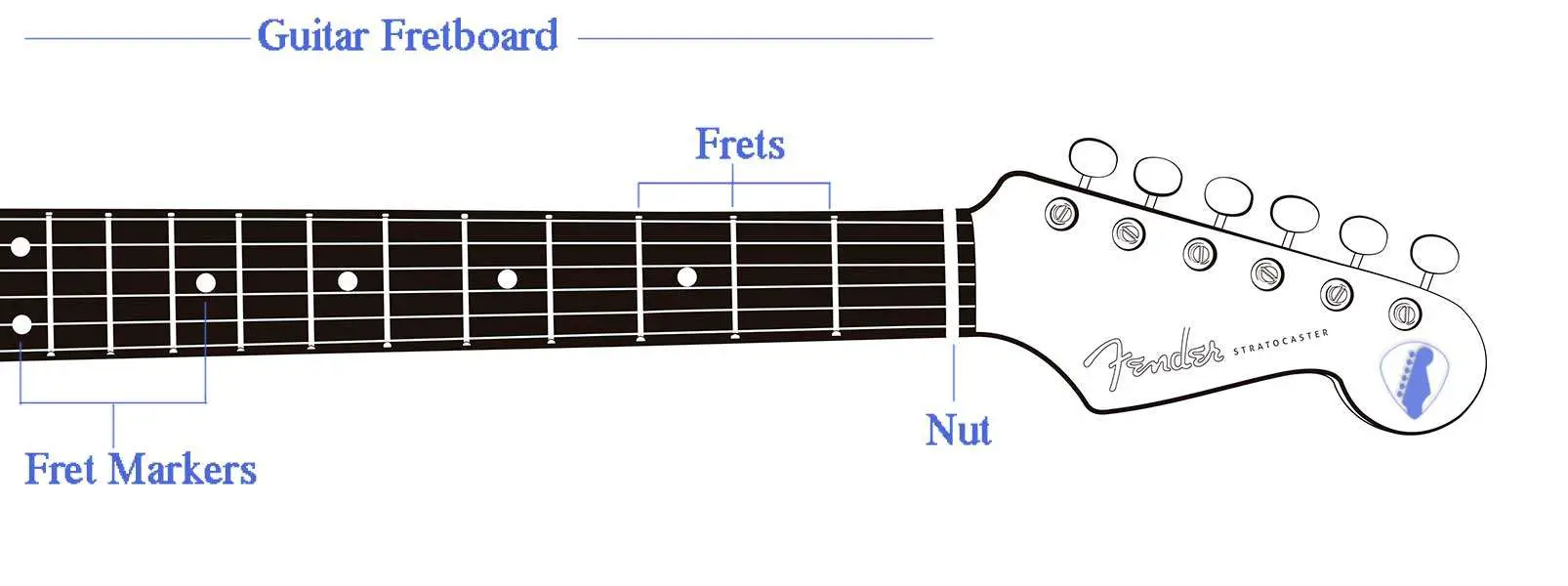
Guitar Neck
The guitar neck is a long, slender component that extends from the body of the guitar to the headstock. It is usually made of wood, such as maple or mahogany, and is an integral part of the instrument’s overall structure.
The primary function of the guitar neck is to provide a playing surface for the strings, allowing the player to press down on the frets to produce different pitches.
It houses the fretboard, which consists of metal frets that divide the neck into specific intervals, enabling the player to create various notes and guitar chords.
The neck’s profile & shape contribute to the instrument’s playability and comfort, with different profiles catering to various playing styles.
The Frets
Guitar frets are the metal strips or bars embedded on the fretboard of a guitar. They act as divisions along the neck, allowing players to create different pitches by pressing the strings against them.
Frets serve as reference points for finger placement, making it easier to play chords, melodies, and scales in the desired positions. They ensure accurate intonation and contribute to the overall playability and sound of the guitar by determining the length of the vibrating string and thus the pitch of the notes produced.
Fret Markers
Guitar fret markers are small visual indicators placed on the side or top of the fretboard to assist players in navigating the neck. They serve as reference points to easily identify specific fret positions, particularly when playing in higher regions of the neck.
Fret markers are typically located at specific intervals, such as the 3rd, 5th, 7th, 9th, 12th, 15th, 17th, 19th, 21st, & 24th frets, making it easier to find the fretboard without needing to count frets
The side markers are usually just dots, as are some of the fretboard markers. However there are also triangle designs, “sharktooth” designs, and over aesthetic inlays such as vines, bats, band logos, birds, and so on.
Fretboard
The fretboard, also known as the fingerboard, is a flat or slightly curved, usually wooden surface located on the front side of the guitar neck. It’s the playing surface that holds the frets & where the strings are pressed down to create different pitches.
The purpose of the fretboard is to provide a smooth and durable platform for the player’s fingers to navigate the neck and press the strings against the frets to produce specific notes and chords.
It is usually made from materials like rosewood or maple and is often adorned with fret markers or inlays as previously mentioned.
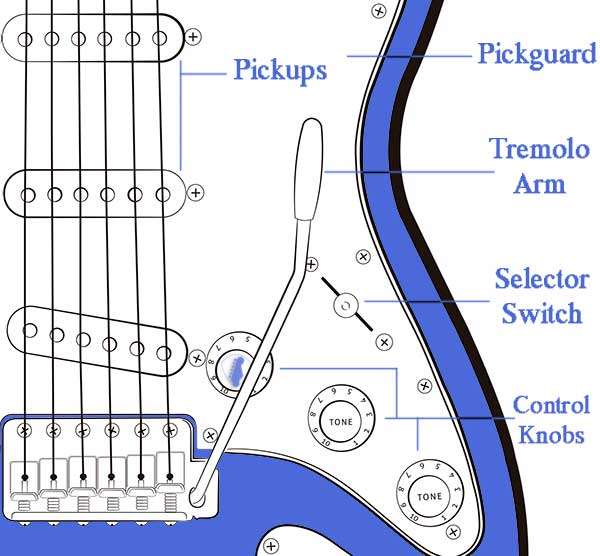
Pickups
Guitar pickups are essential to electric guitar anatomy and are devices located beneath the strings that convert string vibrations into electrical signals using magnets.
They come in two main types: single coils and humbucker pickups.
Single coil pickups have a bright and clear tone, providing a classic sound often associated with genres like blues and country.
Humbucker pickups offer a thicker and fuller tone with reduced noise, making them popular in genres like rock and metal.
The purpose of guitar pickups is to capture the electric guitar sound & transmit it to an amplifier, allowing for amplification and shaping of the instrument’s tone.
There’s also different positions for these such as the neck pickup, middle pickup, and finally the bridge pickup.
Pickguard
The pickguard is a protective plate, often made of plastic or other protective materials, that is placed on the body of the guitar, below the strings and around the pickups.
Its purpose is to safeguard the guitar’s body from scratches, dents, or other damage that may occur during playing, particularly from the strumming or picking motion.
The pickguard acts as a barrier between the guitar’s finish and the player’s hand or pick, preventing direct contact and reducing the risk of wear and tear. It also serves as a decorative element, allowing for customization and adding a visual touch to the overall aesthetic of the guitar.
Tremolo Arm
A tremolo bar, also known as a whammy bar, is a lever attached to the bridge of certain electric guitars. It allows the player to manipulate the pitch of the notes by moving the bar up or down.
By pushing or pulling the tremolo bar, the tension on the strings changes, causing the pitch to either increase (upward movement) or decrease (downward movement).
A tremolo bar is used to create expressive pitch variations, vibrato, or dive-bombing effects, adding dynamic and dramatic elements to the guitar’s sound. It’s available only on electric guitars equipped with tremolo bridges, which are designed to accommodate its use.
Pickup Selector Switch
A guitar pickup selector switch, commonly known as a pickup switch, is a switch or toggle found on the guitar body or pickguard. Its purpose is to allow the player to choose between different pickups or pickup combinations on the guitar.
There are typically two-position, three-position, and five-position switches. A two-position switch selects between two pickups, usually the neck and bridge pickups.
A three-position switch adds the option of using the middle pickup, while a five-position switch provides additional pickup combinations and tonal variations. The pickup selector gives you the ability to select a desired pickup configuration, enabling you to achieve a wide range of tones & styles while playing.
Control Knobs
The volume and tone controls are rotating components on the guitar body or pickguard that adjust specific aspects of the instrument’s sound. The two main types of control knobs are volume knob & tone knob.
Volume knobs control the output level of the guitar, allowing you to adjust the overall loudness.
Tone knobs alter the tonal characteristics of the sound, enabling you to make it brighter or darker sound.
These controls simply provide easy & quick adjustments to the volume or tone knob of the guitar, allowing you to shape and personalize your sound on the fly while playing guitar.
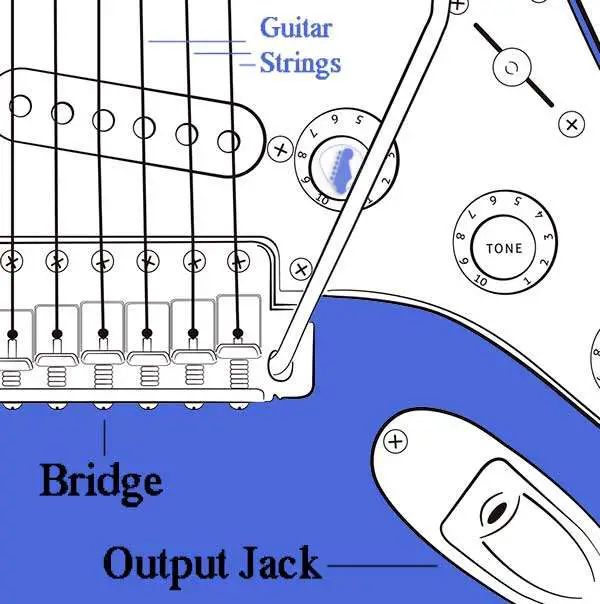
The Strings
Electric guitar strings stretch across the guitar’s body & neck and held in palace by the bridge & tuning heads. There’s typically six strings which are responsible for producing sound when plucked or strummed.
Electric guitar strings are typically made of steel or nickel-plated steel, though other materials like cobalt or titanium can also be used. The purpose of electric guitar strings is to vibrate and create different pitches when played, transmitting the vibrations to the pickups, which then convert them into electrical signals that are amplified and reproduced through an amplifier.
The thickness or gauge of the strings can affect the tone, playability, and overall feel of the instrument, allowing for customization based on the player’s preference.
Related: The guitar string names & notes
The Bridge
A guitar bridge is a component located on the body of the guitar that holds and supports the strings. It provides an anchor point for the strings and helps transmit their vibrations to the guitar body, producing sound.
There are several types of guitar bridges, including fixed bridges (like on a Telecaster), tremolo bridges (like on a Stratocaster), and floating tremolo bridges (Like on an Ibanez RG).
The purpose of the guitar bridge is to hold the strings in place, set their height and spacing, and assist in maintaining proper intonation and tuning stability. It directly affects the playability, sustain, and tone of the guitar.
Output Jack
The guitar output jack is a socket on the body of an electric guitar. It serves as the point of connection for the guitar cable or cord, allowing the electric signal produced by the guitar to be sent to an amplifier, effects pedals, or other audio equipment.
The output jack is typically a 1/4-inch mono jack but can be stereo in certain cases.
When the guitar cable is plugged into the output jack, it establishes an electrical connection between the guitar’s pickups and the external equipment.
This connection allows the electric guitar’s signal to be amplified and shaped, resulting in the production of sound through the guitar amp.
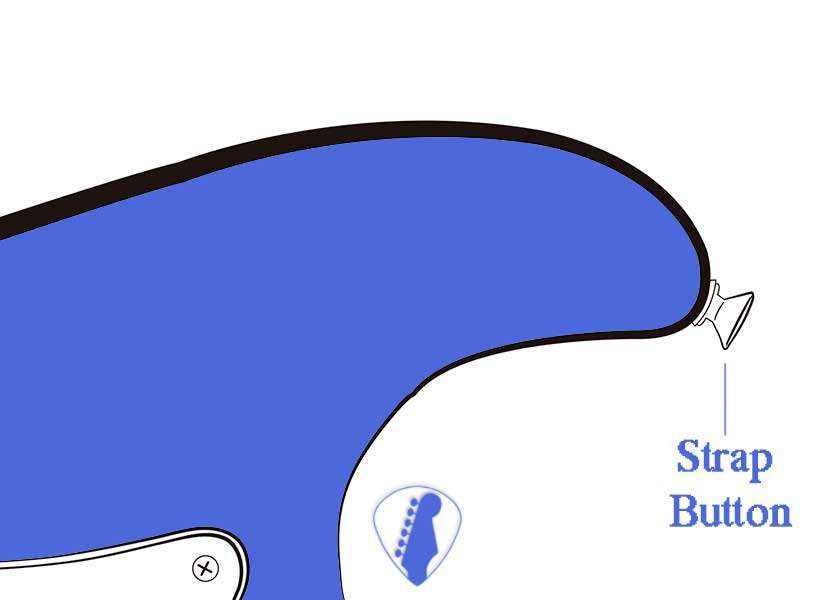
Strap Buttons
Last but not least, is the guitar strap button which is a small metal component typically found on the horn & bottom of the guitar. It’s used to attach one end of a guitar strap, allowing the player to wear the guitar comfortably while standing or moving around.
The strap button serves as a secure anchor point for the strap, preventing the guitar from slipping or falling while playing.
Some electric guitars have locking strap buttons, which offer added security by locking the strap in place to prevent accidental detachment. The strap button is a vital accessory for guitarists, enabling them to play the instrument in a standing position & providing freedom of movement during performances.
Frequently Asked Questions
What are the three basic parts of an electric guitar?
If we had to boil it down to just 3 guitar components, they would be the guitar body, the neck (including the fretboard & headstock), and the pickups which are what make an electric guitar an electric guitar.
Does the body shape of an electric guitar matter?
Yes, the body shape of an electric guitar does matter. When you’re playing, the body shape affects how the guitar feels against your body, influencing your comfort and ease of playing. Additionally, different body shapes can produce variations in tone and sound characteristics, so choosing a body shape that aligns with the style of music you play can enhance your overall sound. Lastly, the body shape can also impact the balance and weight distribution of the guitar, which can affect your playing experience and performance.
What is the most expensive part of an electric guitar?
The most expensive part of an electric guitar can vary, but one component that often contributes significantly to the overall cost is the pickups.
High-quality pickups, along with factors like premium tonewoods, hardware, and electronics, can increase the price. The overall value of an electric guitar is determined by the combination of these components and their impact on playability, sound quality, and craftsmanship.
Electric Guitar Anatomy Summarized
In the world of music, the electric guitar stands as a captivating instrument that holds endless possibilities for creative expression.
Understanding the electric guitar anatomy is key to unlocking its potential and mastering the art of playing. As you explore the electric guitar’s anatomy, you’ll discover various components that work harmoniously to create its distinctive sound.
From the body, neck, and headstock to the pickups, controls, and hardware, each element plays a crucial role in shaping the tone, feel, and overall performance of the instrument.
Whether you’re a beginner embarking on your musical journey or a seasoned guitarist seeking to deepen your knowledge, delving into the electric guitar anatomy will provide you with a deeper appreciation and understanding of this iconic instrument.
